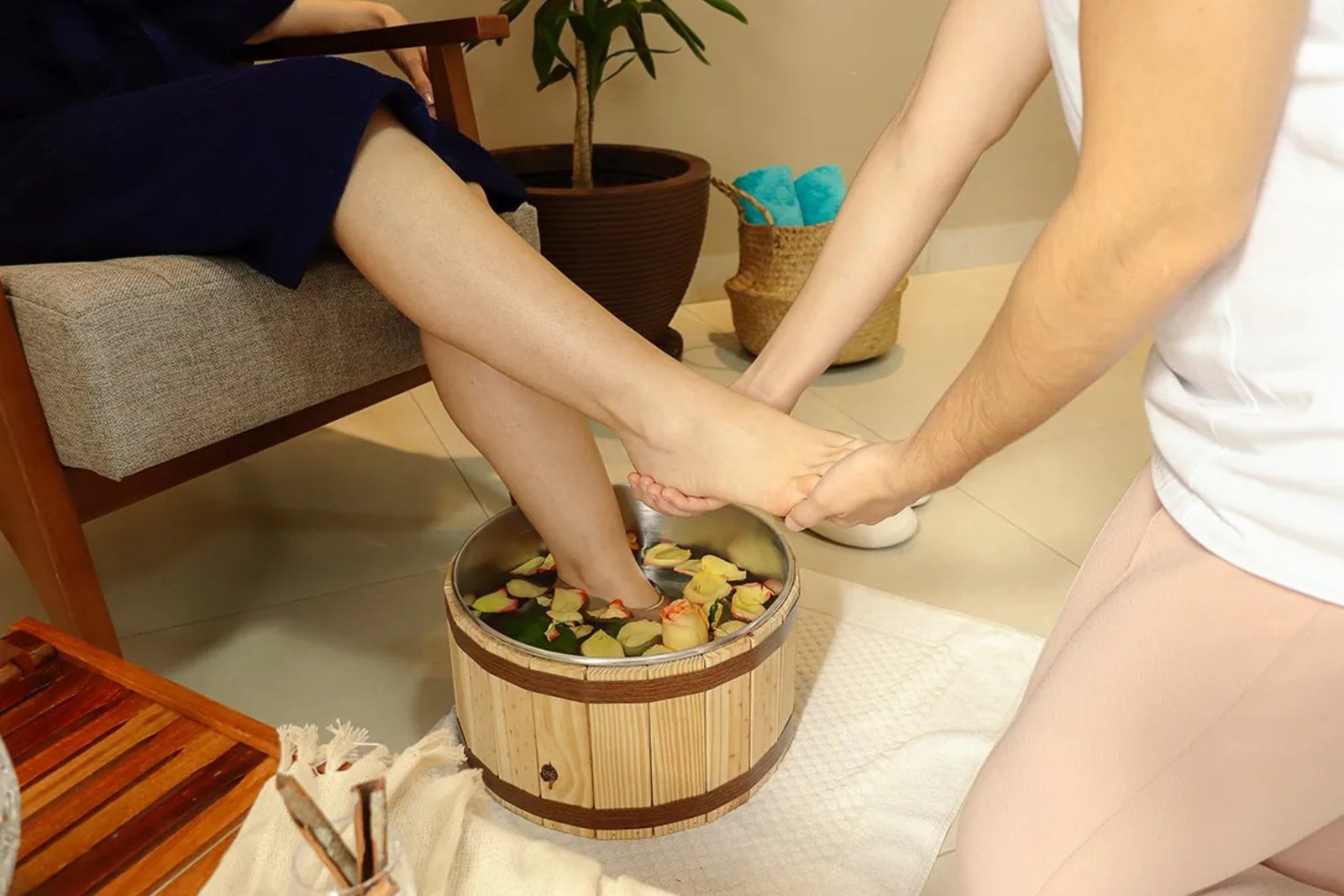The foot soak is an ancient practice that offers a relaxing refuge for the feet and provides a range of health benefits. By immersing the feet in warm water, the body experiences an immediate sense of relaxation, which helps relieve the stress accumulated throughout the day. This technique also promotes the dilation of blood vessels, improving circulation in the extremities, which is especially beneficial for those who suffer from poor circulation or spend long periods standing.
In addition to relaxing muscles and improving circulation, the foot soak is effective in relieving pain and muscle tension in the feet and ankles. Ingredients like Epsom salt, essential oils, and herbs can be added to the water to enhance therapeutic effects, providing additional relief for physical discomfort and improving skin health. The warm water helps soften dry skin and calluses, making it easier to remove dead cells and leaving the feet’s skin soft and hydrated.
Another significant benefit of the foot soak is its ability to improve sleep quality. A foot soak before bed helps relax the body and prepare the mind for a restful night’s sleep.
The practice, often accompanied by aromatherapy with essential oils, not only contributes to physical well-being but also promotes a state of calm and serenity, making it a valuable addition to a self-care routine.
History of the foot bath:
The foot soak has a rich and ancient history, rooted in various cultures around the world. Similar practices to foot soaks were used by civilizations like the Egyptians, Chinese, and Romans, who recognized the therapeutic benefits of immersing feet in warm water. In traditional Chinese medicine, for example, foot soaks were (and still are) used to balance the body’s energy, relieve pain, and improve circulation. The Romans, known for their elaborate bathhouses, included foot baths in their daily hygiene and relaxation rituals, valuing the practice as a way to promote overall health and well-being.
Over the centuries, foot soaks have continued to be a popular practice, especially in both Eastern and Western cultures, where they have been incorporated into self-care rituals and spa treatments. In the West, foot soaks gained popularity during the Victorian era when they became common in domestic health regimes. Today, foot soaks are widely appreciated not only as a relaxation technique but also as a form of complementary therapy to relieve pain, improve skin health, and promote a sense of physical and mental well-being.
Contraindications for foot baths:
Although foot soaks offer many benefits, they are not suitable for everyone. People with severe circulatory problems, such as venous insufficiency or thrombosis, should avoid using very hot water, as it can worsen the condition. Similarly, individuals with diabetic neuropathy, who often have reduced sensitivity in their feet, need to be cautious because they may not feel if the water is too hot, which can result in burns or injuries.
Additionally, those with open wounds, cuts, or infections on their feet should avoid foot soaks, as soaking can delay healing or worsen the infection.
Moreover, pregnant women should consult a doctor before doing a foot soak, especially with very hot water, as it can affect circulation and blood pressure. Another point to consider is the duration of the foot soak; prolonged sessions can cause skin dryness or irritation, especially if ingredients like salt or essential oils are used in high concentrations. Therefore, it is important to follow proper guidelines and, if in doubt, seek the opinion of a healthcare professional before adopting this practice regularly.
How does it promote relaxation?
A foot soak promotes relaxation by immersing the feet in warm water, which helps dilate blood vessels and improve circulation, relieving muscle tension and accumulated stress. The warm temperature of the water provides a comforting sensation and calms the nervous system, while stimulating pressure points in the feet can induce a relaxation effect throughout the body. Adding essential oils to the water enhances this effect, offering additional benefits of aromatherapy that help reduce anxiety and promote an overall sense of well-being.
How can swelling improve?
A foot soak improves swelling by promoting the dilation of blood vessels and enhancing blood circulation in the extremities. Immersing the feet in warm water helps reduce fluid retention and facilitates venous return, alleviating the buildup of fluids that causes swelling.
Additionally, using ingredients like Epsom salt, which has anti-inflammatory properties, can help reduce inflammation and relieve the discomfort associated with swelling, providing additional relief and promoting a feeling of lightness in the feet.
To do a foot soak, start by filling a basin or bucket with warm water, enough to cover the feet up to the ankles. The water temperature should be comfortable and not excessively hot to avoid burns. You can add ingredients like Epsom salt, which helps relieve muscle tension and reduce inflammation, or essential oils like lavender or peppermint for a relaxing and aromatherapeutic effect. If desired, you can also include dried herbs or pumice stones for an even more invigorating experience.
How can I do the foot bath?
To do a foot soak, start by filling a basin or bucket with warm water, enough to cover the feet up to the ankles. The water temperature should be comfortable and not excessively hot to avoid burns. You can add ingredients like Epsom salt, which helps relieve muscle tension and reduce inflammation, or essential oils like lavender or peppermint for a relaxing and aromatherapeutic effect. If desired, you can also include dried herbs or pumice stones for an even more invigorating experience.
After adding the desired ingredients, immerse your feet in the water and keep them submerged for about 15 to 20 minutes. During this time, take the opportunity to relax and enjoy the moment. After the foot soak, dry your feet thoroughly and, if needed, apply a moisturizer to keep the skin soft and smooth. For best results, consider doing foot soaks regularly, especially after a tiring day or when you need a moment of self-car
Also discover these items for foot baths
link bellow













